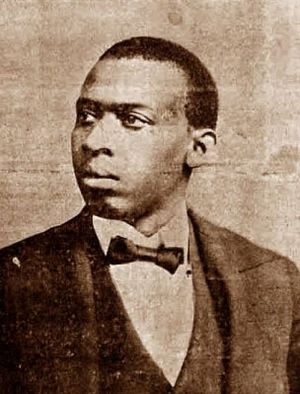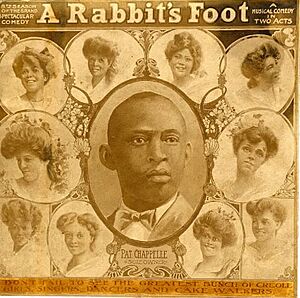Pat Chappelle facts for kids
Quick facts for kids
Pat Chappelle
|
|
|---|---|
 |
|
| Born |
Patrick Henry Chappelle
January 7, 1869 Jacksonville, Florida, United States
|
| Died | October 21, 1911 (aged 42) Jacksonville, Florida, United States
|
| Occupation | Theatre owner, entrepreneur |
| Known for | Owner and manager of The Rabbit's Foot Company, the first travelling vaudeville company owned and managed by African-Americans |
Patrick Henry Chappelle (born January 7, 1869 – died October 21, 1911) was an American business owner. He created and managed The Rabbit's Foot Company. This was a very popular traveling vaudeville show in the early 1900s.
Pat Chappelle was known for hiring many African Americans in the entertainment world. He ran several traveling tent shows. He also owned parts of theaters and saloons. People called him the "Pioneer of Negro Vaudeville." Some even called him "the black P. T. Barnum." He was the only African American to fully run a traveling show with only African-American performers.
Contents
Early Life and Musical Talent
Pat Chappelle was born in Jacksonville, Florida. His parents, Lewis and Anna Chappelle, had been slaves in Newberry County, South Carolina. After slavery ended, they moved to Jacksonville. They helped build the neighborhood of LaVilla. This area became a hub for African-American culture in Florida.
Pat Chappelle was very good at music. He learned to play the guitar and piano. But he was best known for playing the banjo. He left school after fourth grade. Then he played guitar in traveling string bands. He performed in hotels along the East Coast. A famous vaudeville owner, Benjamin Franklin Keith, noticed him. Keith offered him shows in Boston and New York City. Later, Pat played in restaurants and saloons in Florida.
Starting Theaters and Shows
In 1898, Chappelle went back to Jacksonville. He started his first traveling show. It was called the Imperial Colored Minstrels. This show toured successfully across the South. It featured comedian Arthur "Happy" Howe.
Chappelle also opened a pool hall in Jacksonville. He changed it into the Excelsior Hall. This was the first theater in the South owned by an African American. It could seat 500 people. It also sold drinks. In 1898, Pat Chappelle faced a difficult situation. An angry crowd blamed him for an incident at his saloon. Pat Chappelle was badly hurt, but a military officer saved his life.
In 1899, Chappelle closed the Excelsior Hall. He moved to Tampa, Florida. There, he and R. S. Donaldson opened a new vaudeville theater. It was called the Buckingham. The Tampa Morning Tribune newspaper reported on this move. The Buckingham Theatre Saloon opened in September 1899. It quickly became very popular. In December 1899, Chappelle and Donaldson opened a second theater. It was called the Mascotte.
In 1901, the Buckingham Theatre Saloon was renovated. It had a grand opening in December. In 1903, Pat's brother Louis was in charge of the Buckingham. Louis faced legal issues related to the business. Pat Chappelle quickly returned to Tampa. He hired a lawyer to help his brother. The theater was closed for a short time. In 1904, it reopened as the Red Fox Music Hall. It had a pool hall and a fancy café.
The Rabbit's Foot Company
The success of their theaters in Tampa led Chappelle and Donaldson to plan a traveling vaudeville show. In May 1900, they looked for "60 Colored Performers." They wanted talented people for their new show, 'A Rabbit's Foot'. The plan was to travel by train and perform in large tents.
However, things did not go smoothly at first. Chappelle's partnership with Donaldson ended. Business was slow. But in October 1901, the company started its second season. It toured in Alabama, Mississippi, Georgia, and Florida. The show became very popular. It performed in both theaters and tents.
Pat Chappelle and his brothers, James and Lewis, formed Chappelle Bros. They quickly built a small vaudeville circuit. This included theaters in Savannah, Georgia, Jacksonville, and Tampa. By 1902, the Chappelle Bros. circuit controlled African-American vaudeville in that area. They could provide jobs for many performers and musicians.
In Florida, some theaters started to separate audiences by race. To avoid this, Chappelle began using tents for his shows. This helped him earn more money. He stored his equipment at his family's property in LaVilla, Florida. Chappelle also won a discrimination case against a railroad company. The court decided that Black performers traveling in private cars should be treated the same as white performers.
By late 1902, Chappelle proudly said he ran a successful Black show without any white help. As his business grew, he managed many tent shows. The Rabbit's Foot Company traveled to as many as sixteen states. Chappelle was known for creating exciting shows. He often planned parades to go with his performances. This helped attract huge crowds. The company's parade was called "one of the finest street parades in the country."
His shows included drama and classic opera. They also featured chorus show girls and a large musical band. Chappelle hired talented Black entertainers. He advertised in African-American newspapers to find them. The vaudeville shows were very popular. They were known as "authentic" and "clean negro" vaudeville. They traveled successfully in the Southeast and Southwest. They also went to Manhattan and Coney Island.
Chappelle also started an all-Black baseball team. It was based in Jacksonville. The team toured with the company. They played against local teams in each city. The team claimed to be "the championship of the South and South-west."
By 1904, the Rabbit's Foot show had over 60 performers. It used three Pullman railroad cars. It called itself "the leading Negro show in America." Pat's father, Lewis Chappelle, helped manage the company. The show included minstrel performances, dancers, circus acts, and comedy. For the 1904–05 season, the company performed in Washington, D.C. and Baltimore, Maryland.
In 1906, Chappelle started another traveling tent company. It was called the Funny Folks Comedy Company. His cousin, Mitchell P. Chappelle, managed it. The same performers often worked for both companies. In 1908, a newspaper said that "Mr. Chappelle has no equal when it comes to managing these kind of shows." They called him "the black P. T. Barnum." Around 1907, his brothers Lewis and James stopped working with Pat.
In August 1908, one of Chappelle's railroad cars caught fire in Shelby, North Carolina. Several performers were sleeping inside. The fire started when a horse accidentally knocked over a gasoline tank near a stove. Some people were injured. George Connelly was a hero. He tried to save horses trapped in the fire. Two horses were lost, but George saved one. Pat Chappelle was unharmed. He quickly ordered a new car and tent. The show went on the next week. The fire cost him $10,000. In 1909, Chappelle sued a railroad company for overcharging him. He also tried to lower transportation rates for tour shows.
Other Activities and Investments
In the late 1890s and early 1900s, Chappelle communicated well with African-American newspapers. Articles about him and his family were published. The Freeman newspaper published his opinions. It covered the "Rabbit's Foot Comedy Company" often. Chappelle wrote about why there were not more African-American company owners.
Chappelle invested much of his money in real estate. By 1909, he owned many buildings in Jacksonville. He also did a lot of business with the Afro-American bank. These investments showed progress for the Black community.
Retirement and Passing
By 1910, Chappelle was not feeling well. His doctor told him to rest. He traveled with his wife, Rosa, to Georgia and Atlanta. Pat returned to the tour for a short time. Then he left again in the winter of 1910. His brother Lewis took over some daily tasks. His other brother James helped with ticketing. Even without Pat, the show was still a success.
Pat and Rosa traveled in Europe. They wanted to see the coronation of King George V in England in June 1911. They traveled on the RMS Lusitania ship. Pat told The Freeman newspaper that he had enough money to retire. He announced he would not tour that year due to his health.
Pat Chappelle passed away in October 1911 at his home in LaVilla. He was 42 years old. At the time of his passing, he was one of the wealthiest Black citizens in Jacksonville, Florida. He owned a lot of real estate.
After Pat Chappelle's Passing
Pat Chappelle married Rosa (née Brooks) around 1906. They did not have children. After his passing, Rosa married Simuel Decatur McGill. He was a lawyer. Pat Chappelle passed away without a will. His brothers, Lewis and James, claimed a share of his property. They said they had been partners with Pat since 1900. However, the court decided in favor of Rosa and Simuel McGill in 1916. So, all of Pat's property and a life insurance policy went to Rosa. Years later, in 1940, McGill won an important court case that helped innocent people.
Pat's cousin, Mitchell Chappelle, became a minister. He also worked with groups that helped African Americans.
A white carnival owner, Fred S. Wolcott, bought the business in 1912. He kept The Rabbit's Foot Company touring successfully. However, it was no longer an "authentic negro vaudeville." It became more of a popular minstrel show with performances that are now seen as disrespectful. Wolcott still had famous African-American entertainers like Ma Rainey. He moved the headquarters to Port Gibson, Mississippi. The company continued to tour until the late 1950s. A historic marker in Port Gibson remembers the Rabbit's Foot Company. It honors its role in developing the blues in Mississippi.


